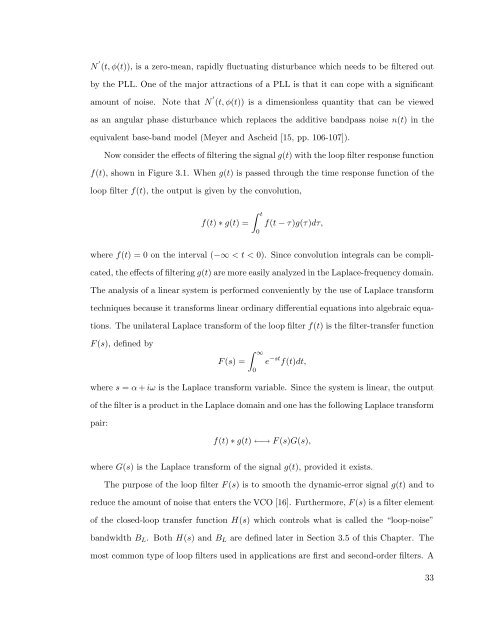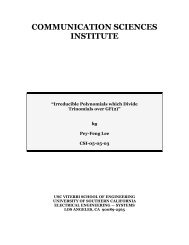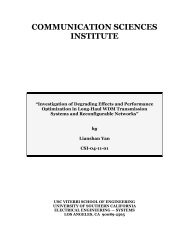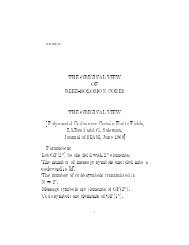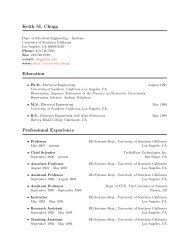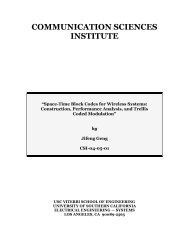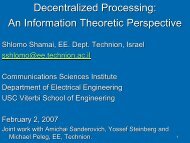Decoding Error-Correction Codes Utilizing Bit-Error Probability ...
Decoding Error-Correction Codes Utilizing Bit-Error Probability ...
Decoding Error-Correction Codes Utilizing Bit-Error Probability ...
Create successful ePaper yourself
Turn your PDF publications into a flip-book with our unique Google optimized e-Paper software.
N ′ (t, φ(t)), is a zero-mean, rapidly fluctuating disturbance which needs to be filtered out<br />
by the PLL. One of the major attractions of a PLL is that it can cope with a significant<br />
amount of noise. Note that N ′ (t, φ(t)) is a dimensionless quantity that can be viewed<br />
as an angular phase disturbance which replaces the additive bandpass noise n(t) in the<br />
equivalent base-band model (Meyer and Ascheid [15, pp. 106-107]).<br />
Now consider the effects of filtering the signal g(t) with the loop filter response function<br />
f(t), shown in Figure 3.1. When g(t) is passed through the time response function of the<br />
loop filter f(t), the output is given by the convolution,<br />
f(t) ∗ g(t) =<br />
∫ t<br />
0<br />
f(t − τ)g(τ)dτ,<br />
where f(t) = 0 on the interval (−∞ < t < 0). Since convolution integrals can be complicated,<br />
the effects of filtering g(t) are more easily analyzed in the Laplace-frequency domain.<br />
The analysis of a linear system is performed conveniently by the use of Laplace transform<br />
techniques because it transforms linear ordinary differential equations into algebraic equations.<br />
The unilateral Laplace transform of the loop filter f(t) is the filter-transfer function<br />
F(s), defined by<br />
F(s) =<br />
∫ ∞<br />
0<br />
e −st f(t)dt,<br />
where s = α+iω is the Laplace transform variable. Since the system is linear, the output<br />
of the filter is a product in the Laplace domain and one has the following Laplace transform<br />
pair:<br />
f(t) ∗ g(t) ←→ F(s)G(s),<br />
where G(s) is the Laplace transform of the signal g(t), provided it exists.<br />
The purpose of the loop filter F(s) is to smooth the dynamic-error signal g(t) and to<br />
reduce the amount of noise that enters the VCO [16]. Furthermore, F(s) is a filter element<br />
of the closed-loop transfer function H(s) which controls what is called the “loop-noise”<br />
bandwidth B L . Both H(s) and B L are defined later in Section 3.5 of this Chapter. The<br />
most common type of loop filters used in applications are first and second-order filters. A<br />
33


